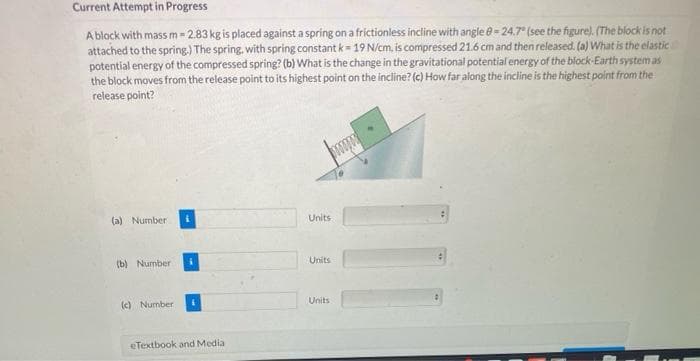A block with mass m - 2.83 kg is placed against a spring on a frictionless incline with angle 0- 24.7 (see the figure). (The block is not attached to the spring) The spring, with spring constant k- 19 N/cm, is compressed 21.6 cm and then released. (a) What is the elastic potential energy of the compressed spring? (b) What is the change in the gravitational potential energy of the block-Earth system as the block moves from the release point to its highest point on the incline? (c) How far along the incline is the highest point from the release point? Units (a) Number (b) Number Units Units (c) Number
A block with mass m - 2.83 kg is placed against a spring on a frictionless incline with angle 0- 24.7 (see the figure). (The block is not attached to the spring) The spring, with spring constant k- 19 N/cm, is compressed 21.6 cm and then released. (a) What is the elastic potential energy of the compressed spring? (b) What is the change in the gravitational potential energy of the block-Earth system as the block moves from the release point to its highest point on the incline? (c) How far along the incline is the highest point from the release point? Units (a) Number (b) Number Units Units (c) Number
Related questions
Question

Transcribed Image Text:Current Attempt in Progress
A block with mass m- 2.83 kg is placed against a spring on a frictionless incline with angle e-24.7 (see the figure). (The block is not
attached to the spring) The spring, with spring constant k= 19 N/cm, is compressed 21.6 cm and then released (a) What is the elastic
potential energy of the compressed spring? (b) What is the change in the gravitational potential energy of the block-Earth system as
the block moves from the release point to its highest point on the incline? (c) How far along the incline is the highest point from the
release point?
(a) Number
Units
Units
(b) Number
Units
(c) Number
eTextbook and Media
Expert Solution
This question has been solved!
Explore an expertly crafted, step-by-step solution for a thorough understanding of key concepts.
Step by step
Solved in 2 steps
